Sweden at last
After spending a beautiful and extremely hot August in Poland I set off to finally begin my Scandinavian journey. I took the ferry from Gdańsk to Nynäshamn, a harbor town on the
east coast of Sweden, about 60 km from Stockholm. I have to admit that the choice to travel by sea was an absolutely fantastic idea. I think that sailing gives you a totally different perspective on your travel, adding to it a sort of magic and making it dreamlike. When it comes to the comforts – I just biked in, left it locked in the car garage below the deck, took the panniers with me and found myself one of the airplane chairs that I reserved before. It was super simple and easy to arrange and comfortable to sleep. I didn’t have to worry about dissembling the bike and packing it in the box how I usually have to do while flying. If I will ever again have the opportunity and time to travel this way I most definitely do it.
After 18 hours of sailing, during which I mostly slept, or otherwise watched the sea from the deck, I arrived in Sweden. My first time ever in Scandinavia, which I desperately wanted to visit for so many years. I was super excited and curious about everything that was waiting for me out there in the “new” land. Honestly, you can laugh, but I almost felt like Columbus discovering New World. Arriving by sea is so incomparable with anything else. You see how slowly the land is becoming bigger and bigger, you pass by small islands and then finally you start recognizing shapes of buildings and houses, water splashing and engines of the ferry working furiously.
The surprise awaited me already ashore. I got a text from my first Swedish couchsurfer Jonas saying that he was awaiting me in the harbor. I was supposed to cycle to Södertälje and meet him there, but instead he cycled 65 km to pick me up and accompany me to where he lived. I can’t imagine a better beginning of a journey, right? On top of that he turned out to be a super nice and interesting person with plenty of his own amazing travelling stories. As we had lots in common we spoke long into the night without being able to finish any subject.
Arriving in Krogstorps Gård
After breakfast I took off to my first WWOOFing farm. I had 55 km to cycle to Krogstorps Gård situated in the nearby town called Gnesta. The route was incredibly picturesque. I couldn’t believe my eyes – the views, oh my, the views were completely breathtaking! All these endless forests of tall trees, plentiful lakes with tiny islands and gorgeous red and white wooden houses! In just few minutes I already knew that Sweden was the best choice I could make for my journey. I’ve been always in love with forests and lakes and here this combination seemed to be the norm, surrounding me from all possible sides. It’s an absolute truth that nature in Sweden is amazing and mind-blowing.

Krogstorps Gård turned out to be just as I imagined my dreamlike Swedish farm – in a good distance from the main street, surrounded by beautiful forests and fields, with two red and white wooden houses and with a very large lake just about 10-15 minutes walking distance. My hosts, Hans and Peter and their friend Mona welcomed me warmly and I was shown around the whole farm. On about 14 hectares they have cows, sheep, goats, chickens, geese, two horses (that were brought about a week before I left), two cats, a dog, greenhouses, a vegetable garden and a few apple and plum trees. I stayed on their organic farm for a month. I enjoyed every bit of it and I’m glad this farm was my first WWOOFing experience. It confirmed my interest in nature, plants and animals and encouraged me to continue exploring the world of natural farming through voluntary work.
Krogstorps Gård was also my first farm experience. I have never before worked with animals or plants. Thus, my knowledge about them was very basic or in some cases none. I was a city person for most of my life so please take into consideration that sometimes I might be explaining things that are potentially for most of you obvious and regular whereas for me they are new and curious.
All the farm animals in Krogstorps Gård (except the cats and the dog of course) are rare and endangered Swedish breeds. The cows and goats were not milked for our use as they fed it to their young offsprings. However, we ate the eggs of the chickens and they were delicious. Hans and Peter grow from a seed and sell organic tomato and pepper plants. Also they have a butcher’s license and plan in the near future to prepare a room for slaughtering in the barn. Soon they will be preparing and selling their own organic meat as well. They had been also working regular jobs in the city (full and part-time) to make ends meet. They are a good example that you can combine both things – having a farm and a job outside of it. It might not be easy, but definitely possible.
Morning animal round and WWOOF schedule
My usual day began with a morning animal round at 7:30 am. First I went to chickens to let them out into their fenced “chicken garden”, check on water, food and if there are any eggs laid. Next I filled buckets with water for geese and let them out. After that I went to check all animal fields; changed the water in the buckets, checked if the electric fences work and if they have salt and mineral stones. I or another WWOOFer repeated the same round in the evening before the supper.
At 8 am we had breakfast at my hosts house where all the meals were eaten all together. We spoke of things that needed to be done and after short break started working. Around 12 or 1pm we gathered for a big lunch with a hot meal. Usually we had about 45 min up to one hour break afterwards. On occasions before lunch we went for a walk with Peter or Mona and Rosso, the dog. Some days Sophia, my hosts’ cute baby daughter was on the farm and then we took walks with her. We worked normally until 4.30 or 5.30 pm. It dependent on the day, tasks and breaks we had. About 6.30-7.30 pm when Hans and Peter were back from work we had supper. Always one of us made sure that chickens were back in the henhouse, geese in their shed and all animals had water.
As a definitely not-a-morning person I thought at first that it would be a challenge to wake up so early, but it turned out that it actually was the best way to begin a new day! I loved to walk around the fields and welcome all the animals in the early morning when the sun was rising; the grass was covered with mist and everything was slowly waking up to life. Later on I understood why I always hated getting up early. The problem was not related to the early hour but with the purpose for which I had to leave my cozy warm bed. As a teenager I was afraid of a test or a teacher at school; as an adult I often suffered going to work I didn’t like or enjoy. Well, also sometimes my boss or manager was a total asshole to be honest. And I need time to wake up well in the morning and I don’t like to be asked questions or talked to too much. That’s actually the only time of the day when I don’t like to talk. I know it’s hard to believe but that’s a fact. Now it turned out that getting up early could be a really nice habit. No questions or talks, no one wanted anything from me and I didn’t have to answer a “super urgent” bunch of emails; it was only the chickens, geese, goats, sheep, cows and I. Perfect companions for a starter!
I love goats
As I said before I had never before been to an animal farm neither had any experience with farm animals. It was an absolutely new thing to me. Quickly I realized that I’m very fond of… goats! The four rams lived in a field just behind my cottage so that I could see them through my windows. Sometimes I liked to sit reading my book on the big rocks in their field and they always kept me company following me wherever I went. They even liked to be petted and reacted when called, just like dogs but with horns 🙂 There was also Inga, a little female goat, who always came running and screaming, climbed on my legs and gave goat kisses.
One of the interesting things that I have learnt about horns of goats and sheep is that they are made of living bone where blood circulates, which makes them warm of course. I always thought that they were like finger nails – dead skin cells. Eyes of goats are also quite cool since they have horizontal slit-shaped pupils that are much more noticeable than in cattle or sheep, because of their pale irises. In September the breeding season commenced and rams smelled very intensively as they produced a special odor that makes them more attractive to females. The scent glands are located at the base of their horns. After learning about that I understood why one of the boys, Nisse, liked to rub his horns on me…

In the mornings I gave the boys fresh branches. I quickly noticed that they don’t like all types of them. Sometimes as a treat I also gave them apples that had fallen down the tree before getting ripe. Both goats and sheep are crazy about apples. One of my tasks was to collect fresh branches and hang them for drying in preparation for winter season and cleaning rams’ shed, which took me hours and dozens of wheelbarrows of last year’s hay.
A few words about chickens and apple tree pruning
 In my first days on the farms I also learnt a bit about chickens. We had about 15 hens and a rooster (which unfortunately and surprisingly I found dead one morning.) We let them out of the henhouse in the morning, but kept in the fenced area until after lunchtime. Generally
In my first days on the farms I also learnt a bit about chickens. We had about 15 hens and a rooster (which unfortunately and surprisingly I found dead one morning.) We let them out of the henhouse in the morning, but kept in the fenced area until after lunchtime. Generally
the reason for that were the eggs, which they would lay all around the farm otherwise. We never took the eggs first thing in the morning so that they wouldn’t get scared that they were gone. We collected them after lunch. (photo of me holding eggs) One day I found out that anyhow one of the hens had four little gorgeous chicks. We placed a special chicken house inside their henhouse and put the mother and her little ones in there. They stayed there for a few days until the little chicks got bigger. The hen mother was super protective. Whenever I was opening the cage to put some food and change the water I had to be very careful as she was aggressive and tried to bite my hand. Good Mama!
One day Peter took me pruning apple trees at the neighbor’s farm. I had no idea that it is such a complex task that needs a lot of knowledge of trees. Depending of what you want to gain (for instance to get more fruit or get branches growing in certain directions) you have to cut them in a precise way. He explained to me only the basics and it already seemed pretty complicated. Still, I think pruning is a very pleasant work that makes you appreciate trees even more. I will try to learn more about it in the future.
Our WWOOF neighbors and Annual Organic Market Fair
About two kilometers from us there was another WWOOFing farm run by a lovely vegetarian couple, the Peterslunds. One day my hosts arranged a visit for me at their farm. I spent half a day helping Malin to harvest, clean and pack beetroots, chard, and tomatoes. They are a part of association of organic farmers who deliver veggie boxes on demand and sell at organic market fairs. Peterslunds’s farm has 1.5 ha of all sorts of vegetables: beetroots, kale, cabbage, carrots, broccoli, Brussels sprout, lettuce, leek, tomatoes, zucchini and more. A beautiful view!
Malin explained me a lot about growing certain veggies and one of the things that was new and surprising to me was the fact that tomato plant contains small amounts of the toxic alkaloid tomatine. Also the fruit pollen that covers them is better not to be consumed. Of course only in great amounts, no worries if you have few tomatoes straight from the branch! However, it is always better to wash them first before eating. She also showed me how to pick ripe fruits by breaking the little joint on the branch close to the tomato. This way they come out easily without breaking the fruit. Malin and her husband had been receiving volunteers already for about eight years. There were 3 of them coming soon, among which one was Polish and arriving also on a bike! Malin invited me to join them at Sunday’s annual organic market fair that was held in a town a few kilometers away. It was a big eco event and of course I was eager to take part in it.
Unfortunately it was very rainy on that day but anyways we happily went to the market fair. Two of the WWOOFers that arrived on Peterslunds’ farm were German (a girl and a boy) and a Polish guy. All of them seemed to be very nice, joyful and young. The market fair was very big and pretty crowded; besides piles of deliciously looking veggies it had all sorts of handmade things of organic materials – clothes, cosmetics, jewelry, carpentry etc. It was set up on the property of a school that holds classes of organic farming and gardening for adults and children. We helped the Peterslunds’ a bit at their stand and walked around the market and gardens of the school. I got myself super comfy and warm woolen socks that are a treasure during rainy and cold days and nights. We agreed with other WWOOFers to get together on the weekend and do an excursion into the woods or to one of the towns in the neighborhood. Even though so far I enjoyed my solitude, it sounded like a great plan and I was looking forward to it!





 The vegetable garden was placed on the lower terrace – flat side of the property that received a good amount of sun. Since it was early December and the temperatures were not too high we didn’t have a lot work planting and harvesting in the garden. However, we cleaned two of the parcels from the remaining previous crop and planted beans and garlic. When it comes to harvesting we had some spinach, arugula, cauliflower, parsley, onions, swiss chard and lettuce that we picked. Spinach for instance I used for my pierogies stuffing and it was delicious.
The vegetable garden was placed on the lower terrace – flat side of the property that received a good amount of sun. Since it was early December and the temperatures were not too high we didn’t have a lot work planting and harvesting in the garden. However, we cleaned two of the parcels from the remaining previous crop and planted beans and garlic. When it comes to harvesting we had some spinach, arugula, cauliflower, parsley, onions, swiss chard and lettuce that we picked. Spinach for instance I used for my pierogies stuffing and it was delicious. 

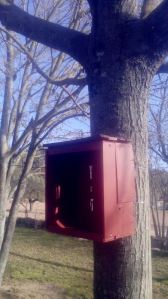

 The other day we gathered together with few other women and turned one of the kitchen-dining rooms into “real” lab. We had many different oils, essentials, powders, hydrosols, fresh calendula flowers and necessary equipment. After few hours of brewing potions like some kind of beauty witches, we received three different creams – for face, eyes and butter cream for body. Too bad you can’t smell these wonderful essences! The creams I made as a present for Christmas for my Mom and some small samples for my besties in Warsaw. Making homemade cosmetics is very pleasurable, natural and not that complicated as long as you have good recipes, ingredients and proper equipment. I hope in the future I will make some more!
The other day we gathered together with few other women and turned one of the kitchen-dining rooms into “real” lab. We had many different oils, essentials, powders, hydrosols, fresh calendula flowers and necessary equipment. After few hours of brewing potions like some kind of beauty witches, we received three different creams – for face, eyes and butter cream for body. Too bad you can’t smell these wonderful essences! The creams I made as a present for Christmas for my Mom and some small samples for my besties in Warsaw. Making homemade cosmetics is very pleasurable, natural and not that complicated as long as you have good recipes, ingredients and proper equipment. I hope in the future I will make some more! 

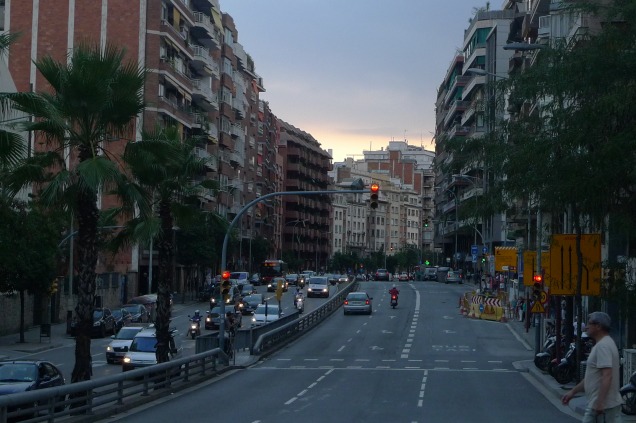






 I almost forgot about one more little detail. I got myself a present in Copenhagen – a new race bike tattooed on my right wrist. On the beginning of my journey I promised myself that I would get a bike tattoo if I manage to get all the way to Denmark on two wheels and I did! From Nynashamn in Sweden to Copenhagen in Denmark; almost 900 km, 13 couchsurfing hosts + Trine and 2 WWOOF farms. Quite an extraordinary experience. Now, this bike will always remind me of these two months in Scandinavia that were filled with lots of learning, thinking, reflecting and analyzing, but also enjoying, resting and relaxing. The route was filled with beautiful and happy moments, but also sometimes with difficult and stressful ones. I had been fighting with my thoughts many times, pushed myself to the limits and learnt to enjoy the best I can whatever comes on my way. It was a new and powerful lesson and now I was about to go back to Barcelona and face reality. Soon I would have to make a decision about what I want to next – look for a new job in Barcelona or hit the road again.
I almost forgot about one more little detail. I got myself a present in Copenhagen – a new race bike tattooed on my right wrist. On the beginning of my journey I promised myself that I would get a bike tattoo if I manage to get all the way to Denmark on two wheels and I did! From Nynashamn in Sweden to Copenhagen in Denmark; almost 900 km, 13 couchsurfing hosts + Trine and 2 WWOOF farms. Quite an extraordinary experience. Now, this bike will always remind me of these two months in Scandinavia that were filled with lots of learning, thinking, reflecting and analyzing, but also enjoying, resting and relaxing. The route was filled with beautiful and happy moments, but also sometimes with difficult and stressful ones. I had been fighting with my thoughts many times, pushed myself to the limits and learnt to enjoy the best I can whatever comes on my way. It was a new and powerful lesson and now I was about to go back to Barcelona and face reality. Soon I would have to make a decision about what I want to next – look for a new job in Barcelona or hit the road again.



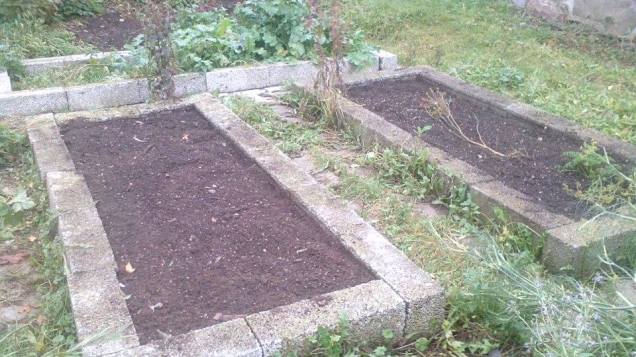

 ith the quality and richness of the soil made from the compost. Folke built his two-bin composter with removable bricks made of LECA (Light Expanded Clay Aggregate.) It was large and deep, divided in two sections with a net and protected with a sliding cover. First they use one of the bins and once it is full of organic matter they switch to the other one and scatter from time to time a bit of charcoal on top of it. Worms working from bottom to top easily can move between the sections, and to keep it moistened, if it doesn’t rain they water it a bit. Folke told me that in approximately 6 months, good and rich soil is created. When I used it for the fields I noticed that its composition was moist and there were many worms in it; it looked very good to me.
ith the quality and richness of the soil made from the compost. Folke built his two-bin composter with removable bricks made of LECA (Light Expanded Clay Aggregate.) It was large and deep, divided in two sections with a net and protected with a sliding cover. First they use one of the bins and once it is full of organic matter they switch to the other one and scatter from time to time a bit of charcoal on top of it. Worms working from bottom to top easily can move between the sections, and to keep it moistened, if it doesn’t rain they water it a bit. Folke told me that in approximately 6 months, good and rich soil is created. When I used it for the fields I noticed that its composition was moist and there were many worms in it; it looked very good to me.

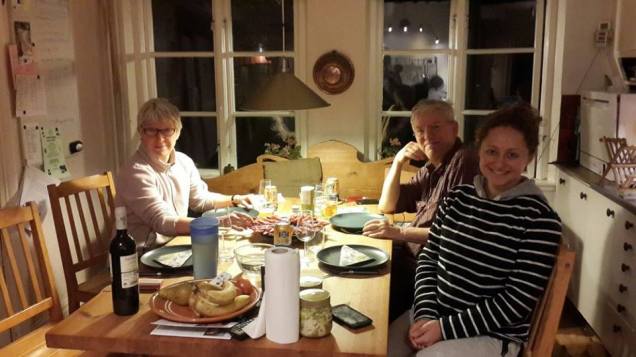


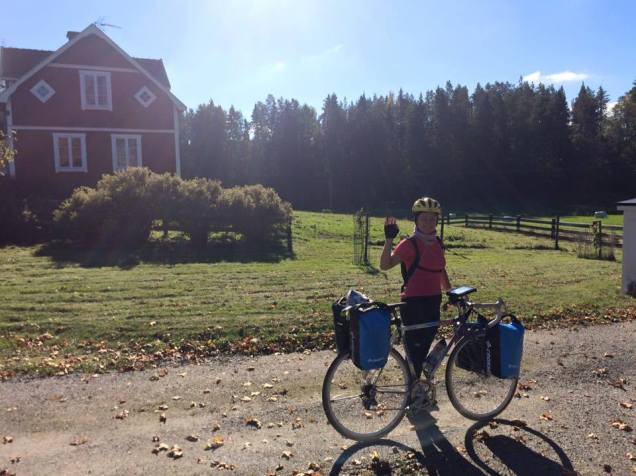
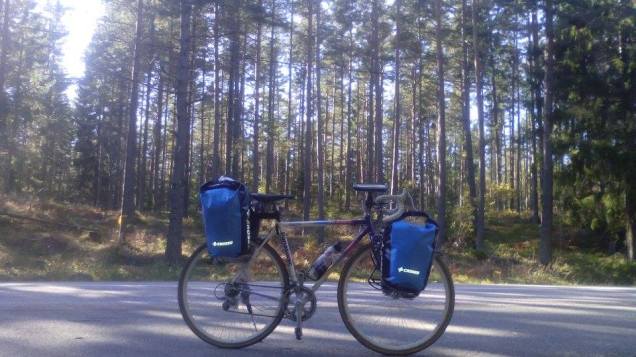
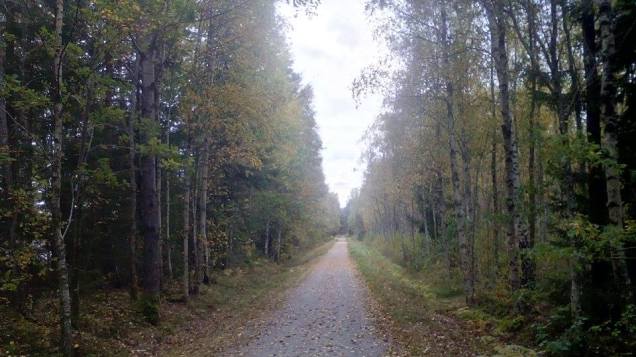
 A few days into my cycling journey I understood why people so often say that solo trips are mind clearing and heart opening. At first I was more concerned about my gear, distance, condition or my day target, but with time I started to sink into my deep thoughts and reminiscences. I reflected on my past, considered the present and wondered about the future. I went over and over again situations that happened, questioning if they could go other way around and what that would mean for me. But deep inside of me I began to fully understand that there are no rights or wrongs, all of it that happens we should see as a new experience and a lesson. After all I wouldn’t be here if I took a different turn in the past, right? Who knows if I would know my best friends? Or seen places I travelled to? Everything would be different so, – no regrets! – I decided. From now on I will try my best to enjoy whatever world brings on my path and try to learn from my achievements, failures, good and bad choices. And importantly, live this life like I please not like someone tells me I should. Don’t look back at others, because it is me living in my skin and no one can feel or understand what is going on inside me better than I could. It was time to put and end to commonly acclaimed stereotypes and live the way I felt was right for me. And I felt that I don’t want to come back to my regular life. At least not yet and not any time soon. I wanted to reconnect with nature, find fulfillment in my daily work and purpose of it. I decided I would continue WWOOFing after coming back to Spain and slowly discover where it would take me.
A few days into my cycling journey I understood why people so often say that solo trips are mind clearing and heart opening. At first I was more concerned about my gear, distance, condition or my day target, but with time I started to sink into my deep thoughts and reminiscences. I reflected on my past, considered the present and wondered about the future. I went over and over again situations that happened, questioning if they could go other way around and what that would mean for me. But deep inside of me I began to fully understand that there are no rights or wrongs, all of it that happens we should see as a new experience and a lesson. After all I wouldn’t be here if I took a different turn in the past, right? Who knows if I would know my best friends? Or seen places I travelled to? Everything would be different so, – no regrets! – I decided. From now on I will try my best to enjoy whatever world brings on my path and try to learn from my achievements, failures, good and bad choices. And importantly, live this life like I please not like someone tells me I should. Don’t look back at others, because it is me living in my skin and no one can feel or understand what is going on inside me better than I could. It was time to put and end to commonly acclaimed stereotypes and live the way I felt was right for me. And I felt that I don’t want to come back to my regular life. At least not yet and not any time soon. I wanted to reconnect with nature, find fulfillment in my daily work and purpose of it. I decided I would continue WWOOFing after coming back to Spain and slowly discover where it would take me.

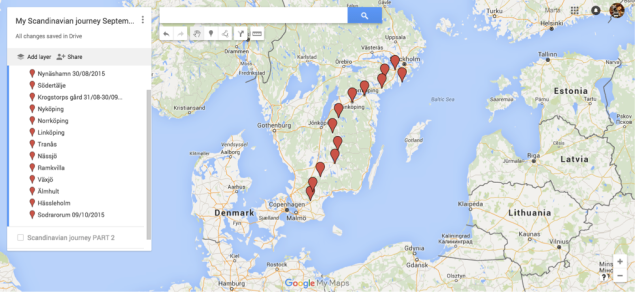

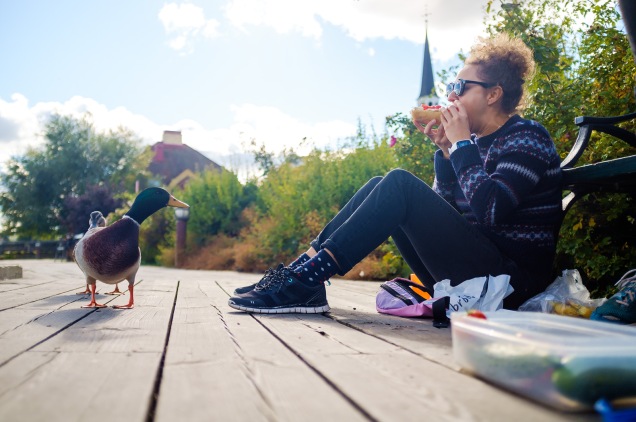

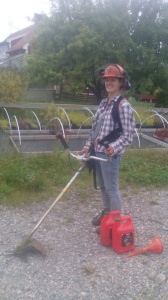

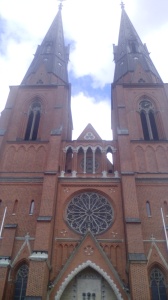


 In my first days on the farms I also learnt a bit about chickens. We had about 15 hens and a rooster (which unfortunately and surprisingly I found dead one morning.) We let them out of the henhouse in the morning, but kept in the fenced area until after lunchtime. Generally
In my first days on the farms I also learnt a bit about chickens. We had about 15 hens and a rooster (which unfortunately and surprisingly I found dead one morning.) We let them out of the henhouse in the morning, but kept in the fenced area until after lunchtime. Generally